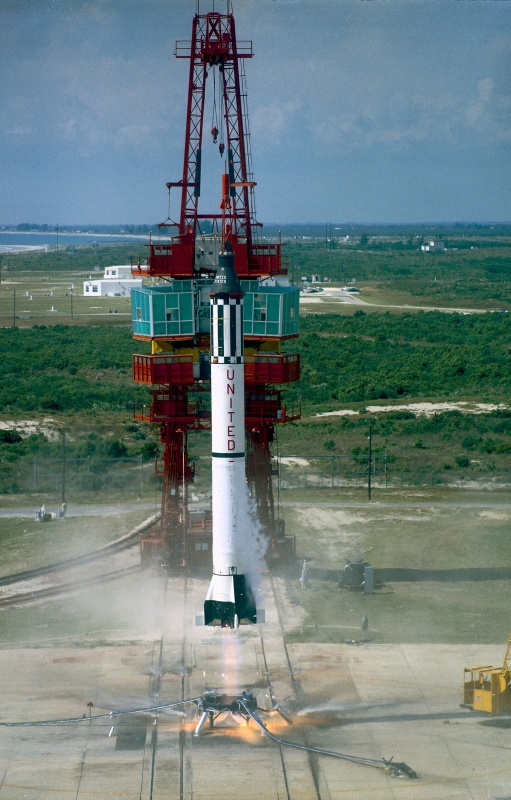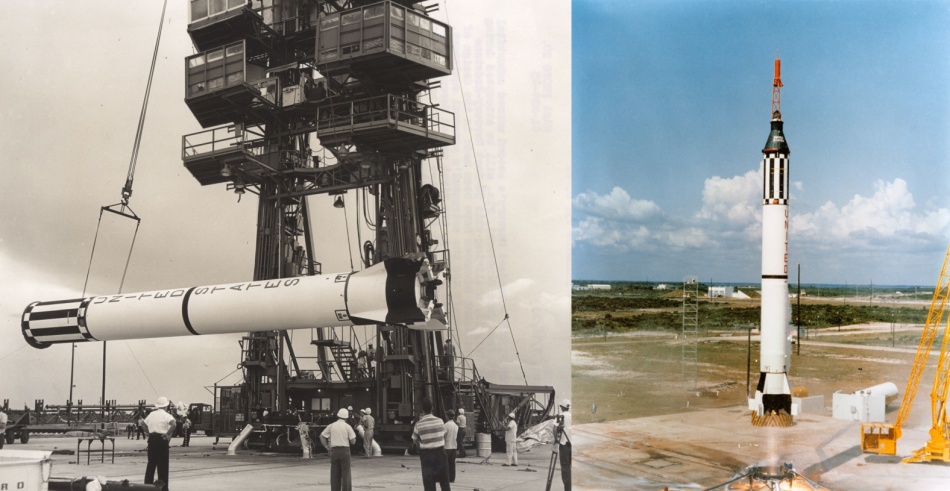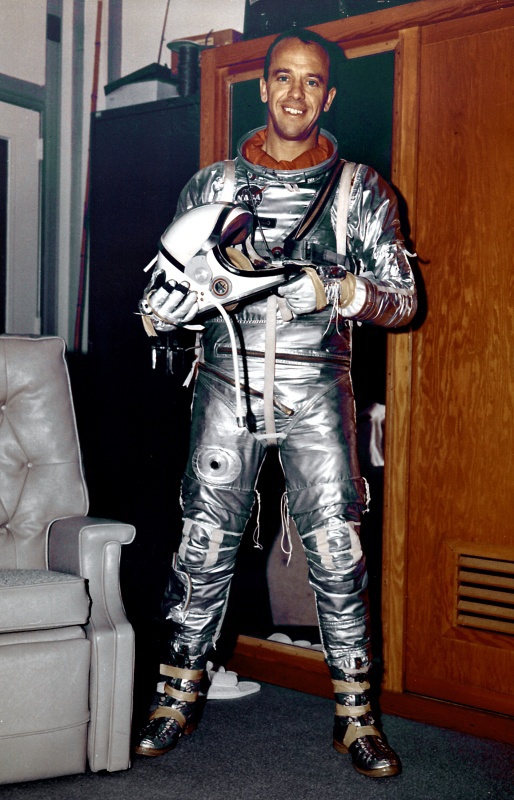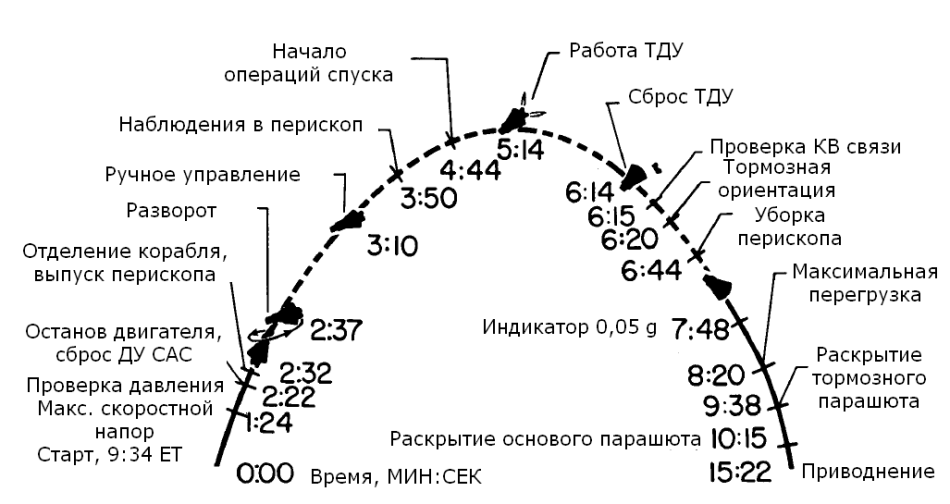The first jump into space the United States

It is good when some historical event is equipped with cameras from different angles, so that later you can see what happened. It is even better when the event is not very long, so that the chronicles will not get bored. According to these two parameters, the first American flight into space on May 5, 1961 turns out to be clearer than Gagarin's flight - there were two cameras on the Mercury-Redstone 3, one of which was shooting an astronaut, and the second was an instrument panel. And the fact that the flight was suborbital, meant that it would last only fifteen minutes, in contrast to the relatively long orbital flight of Gagarin for 108 minutes. Cosmonautics enthusiasts even made several commercials with the reconstruction of this flight. And to the one that I liked more, I added Russian subtitles.
A little bit about the program "Mercury"
The Mercury program is the first manned space flight in the United States. Her tasks were to create a manned spacecraft and explore the possibility for man to be in space. According to the Mercury program, six manned flights were made: two suborbital flights and four orbital flights. The first suborbital flights were to some extent a necessary measure - the US was slowly developing the Atlas ICBM , which was supposed to take the ship to a "full" orbit. Therefore, we had to improvise - to take the less powerful, but mastered BRSD "Redstone" and instead of orbital flights to make "jumps" into space. In principle, suborbital flight made it possible to feel ten times longer than on an airplane, weightlessness (5 minutes vs. 30 seconds) to “get to know” it, and there were even plans to acquaint every astronaut with weightlessness in a suborbital flight before orbital flight. But the space race confused all the plans - the success of Gagarin’s flight sharply reduced the value of suborbital flights.
Flight "Mercury-Redstone 3"
The Mercury Redstone 3 mission is the first manned suborbital space flight of the United States and the world's first suborbital manned space flight. It took place on May 5, 1961 and lasted only 15 minutes. The pilot is Alan Shepard.
Ship

At the left - the top view, on the right - the bottom view, the released periscope is visible
')
The ship "Mercury" - single, made under the scheme of a truncated cone. In the narrow part of the ship were parachutes (brake, main and backup), horizon sensors, emergency hatch. In the central part of the ship was located an astronaut, instruments and tanks of consumable components - hydrogen peroxide for the orientation system, helium for pressurization, oxygen for breathing. Outside the broad side of the ship, there was an airborne shock absorber, a thermal shield (beryllium for suborbital flights and fiberglass for orbital flights) and a bunch of dumped brake engines. The ship had a length of 3.3 m, diameter 1.8 m, weight up to 1400 kg. The insufficient payload of the American missiles led to the fact that the “Mercury” was very small and cramped, the internal volume was only 1.7 m ^ 3, and the astronauts said that they did not “sit” in a capsule, but “put it on themselves”.
Carrier rocket

The Redstone launch vehicle, the full name of the Mercury Redstone Launch Vehicle, is modified for manned flights by the BRMM PGM-11 Redstone, a direct descendant of V-2, developed by the team of Werner von Braun. In a combat version, the rocket carried a thermonuclear warhead, space variants were used to launch the first US satellite and other space programs. Starting weight up to 30 tons, diameter 1.78 m, length 25.4 m.
Astronaut

Alan Bartlet Shepard Jr., born November 18, 1923, died July 21, 1998. He graduated from the Naval Academy in Annapolis and served on the destroyer during the Second World War. After the war, he became a pilot, became a test pilot, and in 1959 became one of the seven US astronauts of the first set. Height 180 cm, weight 77 kg.
The mission
Initially, the launch was scheduled for May 2. Shepard and his understudies, Grissom and Glenn, woke up at one in the morning, had breakfast and waited for the teams to leave for the start. But due to weather conditions, the start was canceled. The second attempt was made on May 5th. Shepard took a seat in the ship two hours before the start, at 5:15 am ET. At 7 in the morning the start was postponed for an hour due to cloudiness - the clouds interfered with the rocket observations, and a clear sky was needed for observing the Earth's surface. Then the inverter overheated, and I had to relieve excessive pressure in the oxygen tank. The start was already delayed by two hours. There was a problem that neither the engineers nor the doctors thought about - for the flight, which was to last only fifteen minutes, no one thought about the astronaut's sanitary and hygienic needs. Simply put, there was no urinal in the suit. More than four hours of waiting in a rocket, not counting travel time and so on, led to the fact that the first American astronaut had to empty his bladder into a spacesuit with the risk of a short circuit. But nothing terrible happened. Shepard with humor reacted to the situation, calling himself a “wet back” and called the MCC “to solve their problems and finally light this candle.” As a result, the start took place at 9:34 am ET. Start from live watched from 45 to 70 million people, in other words, the whole of America. In schools, classes were stopped, institutions stopped working, even traffic stopped; everyone was following the jump into space.

| Time (MM: SS) | Event | Description |
|---|---|---|
| 00:00 | Start | Start, launch ship hours. |
| 00:16 | Pitch program | The booster reduces pitch from 90 to 45 degrees at a speed of 2 g / sec. |
| 00:40 | End of the pitch program | The booster reaches a pitch angle of 45 degrees. |
| 01:24 | Max Q | Maximum velocity head (28 kPa). |
| 02:20 | BECO | Engine shutdown (Booster Engine CutOff), speed 2.3 km / s. |
| 02:22 | Reset do sas | The emergency rescue system tower is reset. |
| 02:24 | Department | Separation motors add 4.6 m / s. |
| 02:35 | U-turn | The autopilot turns the ship stern forward and sets a pitch angle of -34 degrees (nose down). |
| 05:00 | Apogee | Apogee, height 185 km, distance from start 240 km. |
| 05:15 | Braking | Three solid brake motors operate each for 10 seconds. The interval between starts 5 seconds, their work is superimposed on each other. The speed decreases by 155-170 m / s |
| 05:45 | Periscope cleaning | Periscope automatically cleans up when preparing to enter the dense layers of the atmosphere |
| 06:15 | TDU reset | One minute after braking, the brake motors are reset so as not to close the heat shield. |
| 06:20 | Braking orientation | The autopilot orients the ship to enter the atmosphere aft backward, nose up. |
| 07:15 | 0.05 g (0.5 m / s²) | The autopilot records the beginning of the atmosphere and spins the ship to stabilize. |
| 09:38 | Drag chute | The brake parachute opens, the height is 6.7 km, the speed slows down to 111 m / s. |
| 09:45 | Breather valve | The valve for the outboard air ventilation is opened, the height is 6.1 km. The life support system includes emergency ventilation for cooling the cabin. |
| 10:15 | Main parachute | The main parachute opens, the height is 3 km, the speed of descent drops to 9.1 m / s. |
| 10:20 | Landing shock absorber | 1.2 m high landing absorber opens |
| 10:20 | Fuel discharge | The remaining fuel of the orientation system is automatically discharged. |
| 3:30 pm | Splashdown | The ship splashes down at a distance of about 480 km from the launch. |
| 3:30 pm | Rescue System Disclosure | A search and rescue system is revealed — a green dye in the water, an antenna, and a radio beacon. |
The flight plan was painted literally in seconds, and there were the following experiments:
- Manual orientation. Shepard checked the possibility and convenience of orientation on three axes - pitch, roll and yaw.
- Observation of the Earth's surface. During the periscope, Shepard observed the Earth and reported that the Earth is clearly visible, one can recognize large lakes, islands and other landscape elements.
- Rocket observations. The rocket was not supposed to be far away, but, nevertheless, Shepard did not see her. However, the "Mercury" was a very bad review, so it did not surprise anyone.
- Observations of stars. Shepard was supposed to observe the stars / planets in the viewing window. Unfortunately, because of the strong background light, he saw nothing. Attempts to see the stars led to the fact that he was somewhat out of the schedule, and for the first time, according to his own recollections, he became nervous.
Faults:
- During the flight, only one noticeable malfunction occurred - the reset sensor of the TDU failed. On the dashboard, it was possible to reset the operation - by pressing the button to inform the system that the operation took place, which Shepard took advantage of.
- In Wolfe's book The Right Stuff, it is stated that Shepard forgot to remove the dimming filter from the periscope before the start, and did not dare to shoot it later, so he saw a black and white weakly contrasting picture in the periscope and did not quite sincerely tell the MCC " ". But I did not find confirmation of this information from other sources, the accuracy of this is unknown.
Video reconstruction
The video posted on YouTube uses the following sources:
- Ground camera, takes off the launch of the rocket.
- The camera, shooting astronaut.
- Camera, removing the dashboard.
- Flight reconstruction in Orbiter.
I have repeatedly appealed to the author of the video with a request to add the subtitles made by me to his video. For some unknown reason, he didn’t answer me at all, so I had to act not very nicely - copy the video and add Russian subtitles. Link to the original video is on the video page on YouTube, there are built-in English subtitles, if anyone is interested. I recommend to open the video in a separate tab and deploy to full screen.
There is another video by another author , but there are fewer sources.
If you like the idea of such a reconstruction, I recommend to pay attention to a similar reconstruction of the flight of Gagarin .
Information sources
In addition to Wikipedia, the following sources were used:
“World Manned Cosmonautics. Story. Equipment. People, ed. Yu.M.Baturin, M .: RTSoft, 2005
Tom Wolfe "The Right Stuff".
Data on Shepard on the NASA website - height and weight from there.
Source: https://habr.com/ru/post/227083/
All Articles